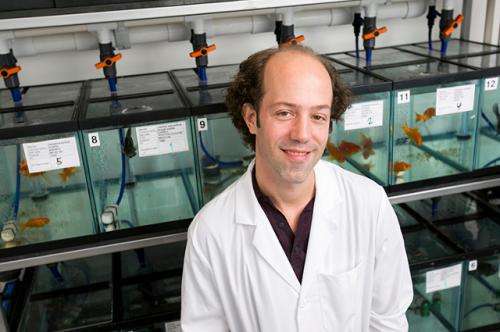Watching fish swim

As fish go, the lamprey has to be one of the most repulsive. Its eel-like body culminates in a tooth-encrusted sucker mouth straight out of a sci-fi horror film. Yet it turns out the lamprey, the most primitive of vertebrates, can do a pretty neat trick: bounce back from paralysis.
"Clip the spinal cord, stick them back in the water, come back in a couple of weeks or so, and they will often be swimming pretty much indistinguishably from how they did before," says Eric Tytell, an assistant professor in the Department of Biology in the School of Arts and Sciences.
The lamprey does repair the break to some extent, but the neurons that connect across the breach are shorter and make fewer, smaller synapses than before. And that, to Tytell, is the more interesting part, because it means that it is not just the connection to the brain that is important for swimming, but something going on in the spinal cord itself.
The cord "isn't a simple cable," Tytell says, explaining that it does a lot of processing in its own right. In fact, neural circuits in the spinal cord, so-called central pattern generators, are what control locomotion. "In fish, that's swimming—in you and me, that's walking," Tytell says. "It's the same structure of the circuit, as far as we can tell." Understanding how lampreys relearn to swim could help in designing better therapies for people who have spinal cord injuries.
The spinal cord work is just a small piece of the research Tytell conducts by doing what many people do only in their dentist's waiting room: watching fish swim. He does it to answer the fundamental question of how fish manage to "move stably through complex environments." He has observed knifefish moving in and out of tubes, scared the bejeezus out of African bichir fish to test their escape reflex, and done seminal work on the fluid dynamics of the American eel. But you can learn other things from fish gazing, such as best practices in underwater propulsion.
The U.S. Navy is always in the market for quieter, more efficient submarines, particularly ones that are nimble enough to get into near-shore areas and search for mines. "It's debatable whether a fish is better than a propeller for long-distance swimming," Tytell says. "It's certainly not debatable that a fish is more maneuverable." Some of his past experiments have included tuning a submersible's rubber fins to undulate like those of a fish.
Tytell is also interested in the ecological aspects of how fish deal with their environments, such as how a bluegill sunfish might react when a well-meaning alternative power company installs a hydrokinetic turbine in its stream. "Clearly these are going to introduce turbulence into the water, and we really don't know how well fish deal with those vortices," he says.
To study things like that, he uses a crystal-clear Plexiglas tank with a constant current for a fish to swim against. When reflective powder is sprinkled in the tank, and a laser is directed in it, a high-speed camera catches the vortices and flows the fish creates as it bends its body and flaps its fins. These flows push back on the fish, creating a complex dance of fluid mechanics and biomechanics.
"There are internal forces and external forces, and the balance of the two is what determines how a fish moves," says Tytell, who has studied both physics and biology and whose bookcase reflects his blend of disciplines, with titles such as Worlds of Flow and Animals in Motion.
The equations involved are so complex that only recently have computers been powerful enough to allow Tytell, while a postdoctoral researcher at the University of Maryland, to develop a robust computer simulation of a swimming fish. This lets him tweak variables such as body stiffness to see how they affect speed or acceleration. It is a model for how a moving body interacts with its surroundings, and something that could one day be used in the creation of robotics and prosthetics. "An awful lot of prosthetics out there right now are entirely passive or have pretty limited ability to adapt to any sort of changes in the environment—going uphill versus going downhill, for instance," he says. "So if we understand a bit better how changing sensory information can change the actual pattern of locomotion, that could help with prosthetic design."
In the meantime, he is gearing up for an experiment on beheaded lampreys. (If you feel bad, think of it as cosmetic surgery.) "You can actually remove the brain entirely, and if you stimulate the circuits in the spinal cord with a drug or electrically, they will swim, they will respond to perturbations, they will do quite a bit of fairly sophisticated stuff," Tytell says.
He points out that in humans, the central processing generator for walking is located in the lumbar spinal cord. "If you can simply activate and then control it at least a little bit—turn left, turn right—then maybe rather than trying to design some fancy exoskeleton, we could take advantage of what is already there. That is very much in the early days, but it is a possibility."
Provided by Tufts University



















